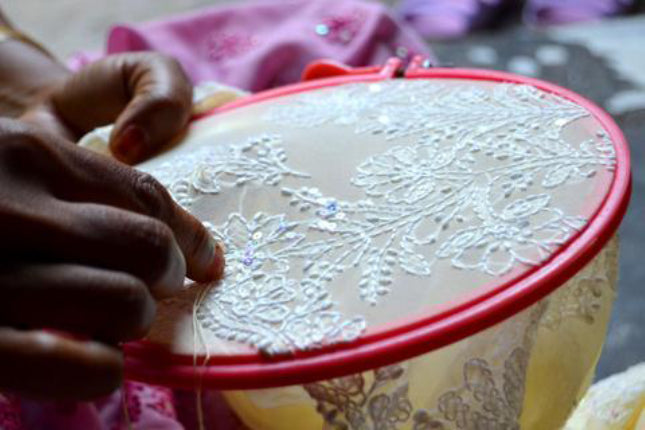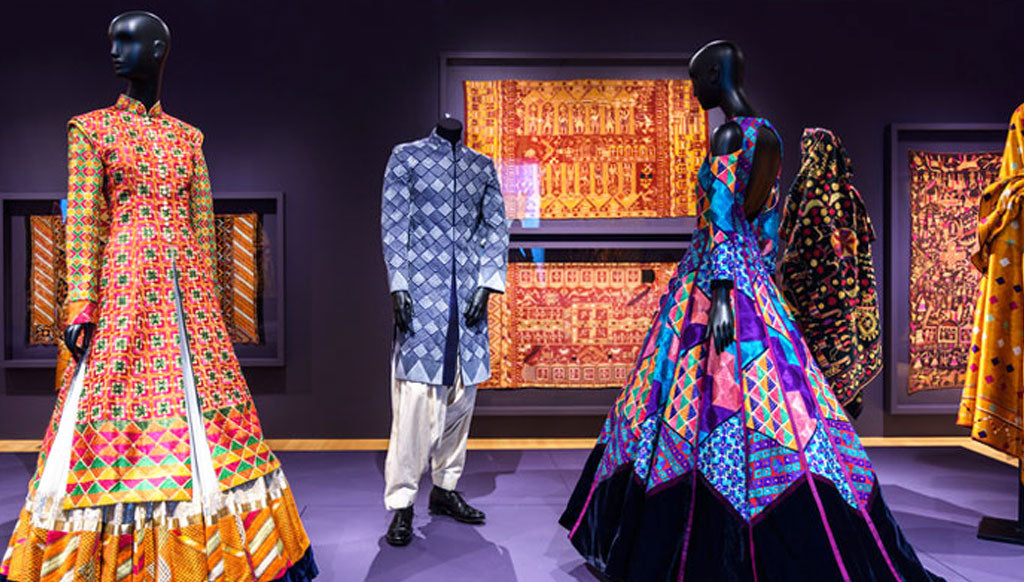We all love our silk sarees and dresses, but often we don't know how they are made or what is the origin. I decided to ask Mr. Google and our weavers and wow I was overloaded with information. So here’s another blog for all my readers giving you the information on silk varieties and their categories.
What is Silk - Silk is made of proteins secreted in the fluid state by a caterpillar, popularly known as 'silkworm'. These silkworms feed on the selected food plants and spin cocoons as a 'protective shell' to perpetuate life. Silkworm has four stages in its lie cycle viz., egg, caterpillar, pupa, and moth. Man interferes with this life cycle at the cocoon stage to obtain the silk, a continuous filament of commercial importance, used in the weaving of the dream fabric. There are so many varieties of Silk in India, it can be categorized in two parts.

1. How it is produced - from which cocoon and worms.
2. Process of weaving, which gives it different texture and strength.
Let's explore the types of silk found in India by its origin and weaves.
1. Mulberry Silk: The bulk of the commercial silk produced in the world comes from this variety and often silk generally refers to mulberry silk. Mulberry silk comes from the silkworm, Bombyx mori L. which solely feeds on the leaves of the mulberry plant. These silkworms are completely domesticated and reared indoors. In India, the major mulberry silk producing states are Karnataka, Andhra Pradesh, West Bengal, Tamil Nadu, and Jammu & Kashmir which together account for 92 % of the country's total mulberry raw silk production.
2. Wild/ Vanya Silk : They are distinguished in looks and feel as they are procured from the wild silkworms that feed on leaves of castor, kesseru, payam, som, sualu, oak, arjun, asan, sal etc… in the open jungles, imbibing the unevenness of nature, and reflecting it in the silks they produce. In unparallel textures, with a natural sheen, an easy affinity for natural dyes, light in weight and high in moisture absorbency, and with baffling thermal properties…warm in winter and cool in summer, products of rich, salubrious climate and nourishing vegetation, each of the Vanya silks has its own unique beauty and ethnic culture. They are distinguished in four different forms: muga, tropical tasar, oak tasar, and eri.
2.1. Tantalizing Tasar:
Tasar silk is produced by tasar silkworms (Antheraea mylitta and Antheraea proylei) that feed mainly on the leaves of Asan, Arjun and Oak. India is the second largest producer of tasar silk and the exclusive producer of Indian tasar Oak tasar (also known as temperate tasar) is mainly used for furnishing, dress materials and sarees. Bomkai, Paithani, Ikkat (tie & dye) and Katki are some popular fabrics produced using tasar silks. Bafta is a popular blend of tasar and cotton. Shawls and mufflers are also produced using a blend of oak tasar and other natural fibers like wool, cotton, etc. Tasar silk is ideal for making jackets for men and women or traditional costumes like the ‘salwar-kurta’. This silk can be styled into beautiful dresses, stoles and scarves. Tasar fabric can also be printed, hand-painted, or, even embroidered into traditional sarees and beautiful dress-material.
2.2.Magnificent Muga Silk: The pride of India, Muga silk is known for its natural shimmering golden color. Its production is confined to Assam, border areas of neighboring Northeastern states, and Cooch Bihar in West Bengal. It is produced by the muga silkworms (Antheraea assamensis), which feed on Som and Sualu. The most expensive of silks, muga is intrinsically woven into the cultural traditions of the people of Assam. The vibrant Sualkuchi sarees and mekhla-chaddars are the traditional items made from muga silk. Use of muga yarn as a substitute for ‘zari’ in sarees is finding favour with reputed weavers.
2.3 Irresistible Eri Silk :Eri silk, also known as the Endi or Errandi silk, is a creamy white-colored silk. It is derived from two domesticated species of silkworms known as Samia ricini and Philosamia ricin. Eri silk is a peace silk since it is spun from the cocoon of the silkworm without destroying the worm unlike mulberry and Tasar silk. Also known as Endi or Errandi, Eri is multivoltine silk spun from open-ended cocoons, unlike other varieties of silk. Eri silk is the product of the domesticated silkworm, Philosamia ricini that feeds mainly on castor leaves. Elegantly designed eri shawls and chaddars are quite popular because of their thermal properties. They can be blended with cotton, wool, jute, or even mulberry silk to create exotic fabrics for use in jackets, or suiting material, or for producing a variety of furnishings, making it an interior decorator’s delight.
Yarns made from Wild Silk :
-
Reeled Tasar / Tasar Raw Silk: It is reeled from Tasar cocoons using the different appliances. Reeled Tasar is finer in nature.
-
Tasar Gicha: Yarn is drawn by hand out of Tasar cocoons without any twist.
-
Tasar Katia: Yarn spun out of Tasar waste after opening and cleaning.
-
Tasar Jhuri: Yarn spun out of uncleaned Tasar waste without subjecting it to the opening and cleaning process.
-
Balkal yarn: Yarn spun out of tasar cocoon peduncles, after boiling in an alkaline solution and opened up.
-
Tasar Spun Silk: Yarn spun in the mill out of Tasar silk waste.
-
Muga Raw Silk: Yarn reeled from Muga cocoons.
-
Muga Gicha: Yarn drawn by hand out of muga cocoons without any twist.
-
Hand Spun Endi/ Eri Silk: Yarn spun by hand appliances from Eri cocoons.
-
Mill Spun Eri Yarn: Yarn spun in the mill from Eri cocoons.
Fabrics Made From Wild Silk :
-
Tasar Fabric: Tasar fabric is normally referred to when reeled Tasar is used in both warp and weft. This Tasar fabric is a popular material for printed / embroidery sarees, gent’s Kurthas, and other dress materials.
-
(Tasar-Gicha-Noil) Fabric: A combination called Tasar/ Gicha/ Noil is a popular export item. Using reeled Tasar in warp and Gicha and Noil in the weft, the fabric is woven on a handloom in different weight ranges.
-
(Tasar – Gicha): Tasar- Gicha is another popular item in the Tasar Silk range and the fabric produced mostly in Bhagalpur and Champa. Reeled Tasar is warp and Gicha in weft is used in this quality.
-
(Tasar-Gicha-Cotton): Reeled Tasar X Gicha+ Cotton is a popular silk blend produced by Bhagalpur weavers for export market. Using cotton in place of Noil the fabric woven is similar to TGN on a lesser cost.
-
(Cotton – Gicha- Noil): Cotton X Gicha + Noil is similar to TGN using mercerized cotton in place of Tasar Silk in the warp, thereby reducing the cost structure. The fabric is quite strong and is mostly used for suiting and furnishings.
-
(Mercirised Cotton-Gicha): Cotton x Gicha is another variety of silk blend made in Bhagalpur. Fabric is durable and suitable for dress material and furnishings.
-
Cotton-Gicha-Cotton: Cotton x Gicha + Cotton is also produced for export orders. In order to bring down the price considerably, cotton has been used in the warp as well as weft with Tasar Gicha.
-
Katia x Katia: Katia yarn used in both warp and weft, fabric is produced mainly for export market. Fabric is quit strong and durable.
-
Jhuri x Jhuri: Jhuri yarn in both warp and weft, heavy fabric is produced. Jhuri fabric in different shades is used for upholstery and also for floor covering.
-
Muga Fabric: Muga fabric is normally referred to when reeled Muga is used in both warp and weft. This Muga fabric is a popular material for sarees, gent’s Kurthas, Ties and other dress materials.
-
Muga Sarees: Muga sarees are made with reeled muga in both warp and weft along with viscose yarn as extra weft for ornamentation. These sarees are the traditional varieties of North-East mainly produced in the Sualkuchi weaving cluster of Assam.
-
Muga Mekhla – Chaddar: Muga Mekhla chaddars are made with reeled MUGA in both warp and weft along with viscose yarn as extra weft for ornamentation. These are the traditional dress of the Northeast mainly produced in the Sualkuchi weaving cluster of Assam.
-
Eri chaddar /shawls: Made of Eri handspun yarn. The Eri chaddars are thick, warm and good for winter.











